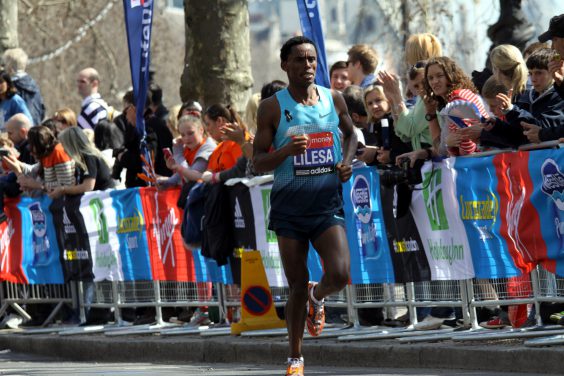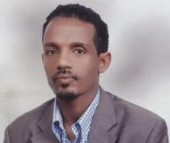Popular Defiance in the Midst of Brute Force
by Chalachew Tadesse / September 2, 2016 / 1 Comment

Olympic athlete Feyisa Lilesa’s image was censored in Ethiopia. Image via Wikimedia Commons.
As Ethiopians band together to break the cycle of fear, the regime cracks down against peaceful protesters.
This August column of “Double-faced Ethiopia” has both good and bad news. Good news first. Ethiopians have exhibited an unprecedented unity in breaking the cycle of fear. Peaceful protesters have shaken the repressive regime to its core. And the bad news is several peaceful protesters have been killed almost on a daily basis in their unprecedented defiance against brute force unleashed by the regime’s vicious security apparatus. Almost all protests were met with brute and ruthless lethal response.

- This column’s topics will include literature, art, education, history, and political culture in Ethiopia, as well as society and politics in the Horn of Africa. Moreover, I will address the tribulations of journalists and the ill-fated constitutional right of freedom of expression under Ethiopia’s deceptive authoritarian regime. I will try to be the voice of the voiceless, be it persecuted journalists at home or exiled journalists abroad. These themes will make Ethiopia’s uniqueness and absurdities evident.

- Chalachew Tadesse is an Ethiopian journalist and columnist. He has previously worked as a full time journalist for The Reporter and The Sub-Saharan Informer English newspapers. He was also a columnist for the much-acclaimed Fact magazine, before the Ethiopian regime closed it in October 2014. A political science student by training, he works as a university lecturer and is known for his sociopolitical commentaries on the Ethiopian private press.
The killing of protesters dates back to November 2015 when the Oromo, the largest ethnic group in the country, protested the regime’s land misappropriation of peasant farmlands. Since then the protest has shown no sign of ending. In the last three months however the regime has unleashed its massive killing machine against peaceful protesters when the Amhara, the second largest ethnic group, joined the protest. As it is a minority regime with little popular mandate whatsoever this scenario is a defining moment.
Since June, a series of violent popular protests have been underway in the two biggest cities in the Amhara region, Bahr Dar and Gondar, opposing unfair distribution of political power and wealth, demanding the release of political detainees, and even regime change. And yet the chanting of slogans by peaceful protesters carrying anti-government placards is sufficient reason for security forces to use lethal force indiscriminately. Following several deaths the residents of the two largest cities chose to conduct a stay-away protest for about a week–the first ever large-scale protest of its kind in the country.
According to the estimates of Human Rights Watch more than 100 protesters have been killed in the first week of August alone in Amhara region. Alas, August turned out to be the bloodiest month since the onset of the protest. Therefore, the total number of deaths has since November reached more than four hundred whereas the number of those arbitrarily arrested is the thousands. And yet that doesn’t tell us the whole story. International human rights bodies say the number of deaths could be higher claiming that it is always difficult to verify reports especially in remote rural towns. Mind you, not even a single international independent human rights body is allowed to operate on the ground in Ethiopia. Long ago the repressive regime effectively shielded the country from the watchful eyes of human rights bodies. Thanks to the regime’s paranoia one can compare the situation of present-day Ethiopia with the recent blanket arrests in Turkey.
At the time of print, the killings and mass arrests is continuing as the violent protests have intensified throughout the Amhara region. Due to complete lockdown, even regular flights have been suspended recently though Gondar and Bahr Dar are the country’s primary tourist destinations. On the 30th August Ethiopia’s Prime Minister ordered the deployment of the national army to quell the protests in the region thereby showing the regime’s determination to crackdown on protesters with brute force.
Following the August killing of more than hundred civilian protesters, the UN High Commissioner for Human Rights called for an independent probe into the killings. The regime wasted no time before rebuffing the request claiming that only the government is has the responsibility to conduct investigations into the allegations of killings on its own. No step has since been taken to that effect though. Neither has the government declared the number of deaths to date although ironically the regime possesses massive security and party apparatus to compile data in few days.
All this barbarism is occurring in a country having a democratic constitution that fully guarantees freedom of assembly, expression and peaceful protest. Ironically, this widespread popular protest came a year after the brazen regime surprised the world with 100 percent victory in the May 2015 general election and President Barrack Obama’s visit to the country last July.
For the Obama Administration, the key ally of the repressive regime, Ethiopia is indeed a poster child. For the West, Ethiopia is perceived as an anchor nation in the troubled Horn of Africa region where the ISIS-affiliate terrorist and jihadist al Shabaab operates in the war-torn state of Somalia. That is why we Ethiopians say the country’s strategic importance is a curse on freedom of expression and democracy so to speak. Having been emboldened by the US deafening silence for decades the regime has continued the indiscriminate killings and mass repression with impunity.
Thanks to social media however the international community is aware about what is going on in Ethiopia more than ever before. Perhaps this present civil defiance is the most-widely covered phenomena by the international media ever. Aware of the role of social media in the dissemination of information however the embattled regime imposed in August a blanket shutdown of the Internet, i.e. Facebook, Twitter and telephone communications for a few days. The government gave the excuse of avoiding disruptions of national exams when it blocked the Internet for the first time in July. Internet access to the protest areas has been difficult since then though.The regime is embattled so it has now started even to use closure of Internet as a means of state censorship against freedom of expression.
Mind you Ethiopia still has the lowest internet penetration in Africa. Out of its estimated 100 million population only 4.2 percent has access to the Internet. Even where access to the Internet is available the speed is disappointingly very poor. Despite this the regime always uses two preposterous scapegoats: pointing fingers at unspecified “rogue foreign-based anti-peace elements” bent on destabilizing the country and legal but weak opposition parties at home.
Most recently, Ethiopian marathon runner and silver medalist Feyisa Lilesa at the Rio de Janeiro Olympic Games also protested against the government’s ongoing killings. In a defiant and unusual move the athlete crossed the finish line with his hands crossed above his head. For the last nine months, the gesture of crossed hands has been used as a sign of protest by most Ethiopians. In the press conference where he repeated the same sign, Lilesa told journalists: “The Ethiopian government is killing my people, so I stand with all protests anywhere,” adding, “if I go back to Ethiopia, they will kill me.” True, it goes without saying that Lelisa will face jail should he return home. Funnily enough the state television censored Lilesa’s iconic image, not airing Lilesa crossing the finish line. Thanks to the athlete’s determination the international media has widely reported the ongoing protest and killings in Ethiopia.
Worryingly, the regime has also shown signals that it is determined to use the ethnic card to incite violence and manipulate public opinion. Since the ethnic Tigrayans are perceived to be associated with the Tigray People’s Liberation Front (TPLF) the core party of the ruling coalition Ethiopian People’s Revolutionary Democratic Front (EPRDF), some international media have recently reported the targeting of Tigrayans in the city of Gondar largely populated by ethnic Amharas. In the writer’s opinion, this is the regime’s attempt to fabricate “ethnic hatred” and “ethnically targeted violence” while in reality such a scenario is no more than a scapegoat to justify the regime’s barbaric crackdown against peaceful protesters. Alas, let the world be aware that the TPLF ethnic fanatics will leave no stone unturned to incite ethnic violence, in which case the regime could continue to assume the role of “arbiter of ethnic tensions” and “guarantor of peace.”
Thanks to the intransigent regime a nation-wide crisis and perhaps civil war is looming over Ethiopia. More than ever before Ethiopians seem determined to defiantly reject repression on their own instead of waiting for the United States to pressure the regime for a democratic opening. And yet wouldn’t it be a shameful scar on the conscience of the international community should Ethiopian authorities get away with these outrageous crimes? Of course, it definitely will.





One Comment on "Popular Defiance in the Midst of Brute Force"
Trackbacks for this post